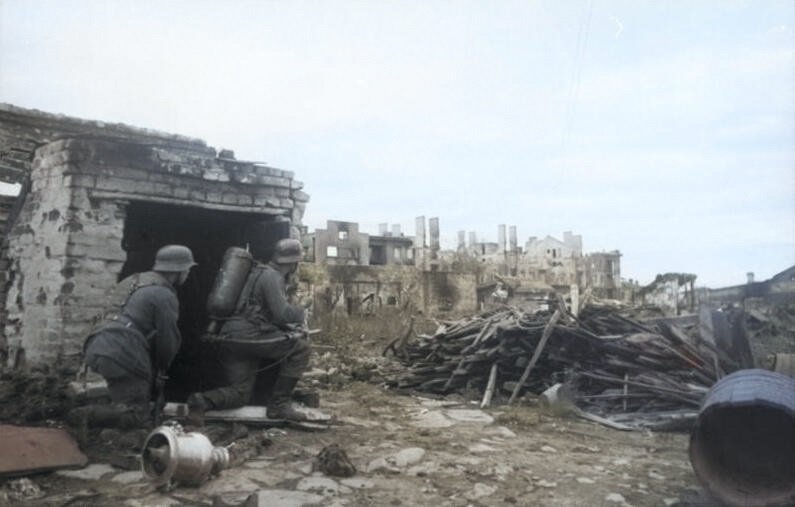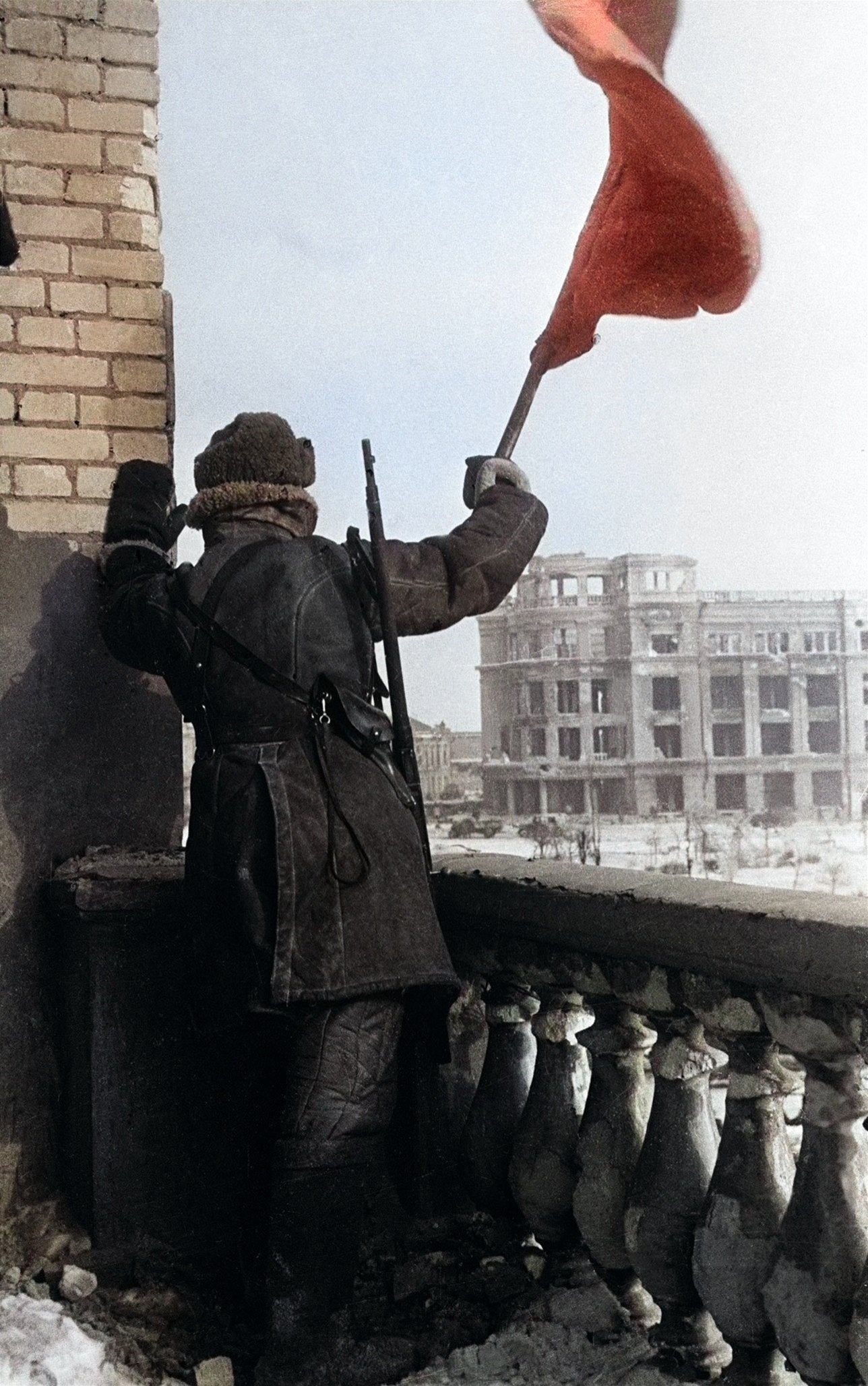The Battle of Stalingrad
Chapter 21
“We will defend the city or die in the attempt.”
23 August, 1942 - 2 February, 1943
A Luftwaffe JU87 Stuka dive bomber over Stalingrad
German Federal Archives
As the Germans advanced in the southern areas of the Eastern Front in late 1942 the objective was not just the oilfields of the Caucasus. Just to the north, the river Volga ran southward into the Caspian Sea, forming a major artery for the movement of men and material into and out of the Caucasus, as well as for the transfer of supplies from the Western Allies via occupied Iran. The most strategic location to sever this connection was the industrial city of Stalingrad which sat at the river’s final major westward bend before heading southeast into the Caspian. If taken, Stalingrad would ensure the protection of the German advance on Baku and its oilfields, as well as serve as a propaganda coup as the city named for the Soviet dictator fell into the Fuhrer’s hands.
German pioneers (engineers) sweep the ruins with a flamethrower
German Federal Archives
As the German Army Group South pushed southward, another subdivision of that army group drove toward Stalingrad, with an advance across the open steppes supported by various Italian, Romanian and Hungarian forces. After crossing the Don, the German spearheads had their northern flanks secured against Red Army counterattacks by these Axis partners, and by August the Wehrmacht was bearing down on the city.
Soviet soldiers advance through a trench between blasted buildings
On 23 August the Germans arrived at the edge of the city, and their drive into it was preceded by a massive air raid by the Luftwaffe, with 1,000 tons of ordnance dropped on the city within the day, devastating most of the urban area and killing large numbers of civilians, whom the Soviet government had refused to evacuate. Local resistance by the VVS was limited, and the Germans could count on air superiority as they advanced into the forest of burnt rubble that was once a proud city. The only unit available for the defense of the city was its anti-aircraft detachment, which was destroyed after a fight to the last of the all-female unit’s guns.
A German howitzer fires directly on the grain elevator
German Federal Archives
Subsequent defense was initially in the hands of emergency “Worker’s Militias”, which consisted of hastily recruited citizens, often without weapons. The Germans, unswayed by this desperate resistance, pressed forward, reaching the banks of the Volga by 2 September, leaving the Soviets with no choice but to ferry reinforcements across the river to the now encircled defenders, under constant German fire and air attacks as they did.
A knocked out T34 on the streets of Stalingrad
German Federal Archives
Attempts at counterattacks in September saw the Red Army constantly beaten back, in no small part due to the aforementioned superiority of the Luftwaffe, but despite these setbacks outside the city, resistance inside was stiffening. The Soviets took advantage of the ruined state of the city to create strongpoints that were difficult for the Germans to approach, as the panzers were often prevented from advancing in the tight, rubble choked streets.
A German sniper sights his rifle in Stalingrad
German Federal Archives
The desperate Soviets hung on with tooth and claw for the city, with Stalin’s Order 227 mandating that there was to be no retreat from the city. The NKVD retained its presence throughout the city, with political officers even executing Soviet soldiers accused of cowardice, as the German assaults were finally blunted after taking the high ground at Mamayev Kurgan in mid September, but still the Soviets were unable to take the initiative. Indeed, one entire division was even destroyed over the course of several assaults against the Germans at the central rail station. In another area an apartment building was seized by a Soviet unit under the command of Sgt. Yakov Pavlov, who promptly turned it into a fortress. Minefields were sewn around it, and emplaced machine guns and heavy weapons around it, resulting in a major strongpoint that commanded the area around a crossroads and guarded an approach to the river. Despite constant German attacks, “Pavlov’s House” would hold out for two months until relieved in mid November.
The German flag flies from the ruined TSUM department store. The headquarters of the 6th Army was located in its basement
German Federal Archives
Elsewhere, heavy fighting raged within a massive concrete grain elevator, where a small force of Red Army troops held off sustained German assaults before finally being overrun when their supplies began to run out, and the Germans made slow progress amongst the ruins. Fighting intensified in the industrial district of the city in late September, with the attackers advancing through a massive hail of artillery and air attacks through the devastated factories, which had until recently been producing tanks, which had been driven straight from the assembly lines into the fighting in the streets. By 20 November, almost the entire city was under German control, with the Red Army only maintaining control of two pockets. But despite the desperate situation, the winter was setting in, and the Soviets were preparing a major counteroffensive intended to capitalize on the inhospitable climate.
A German officer in a position amongst the ruins. Note the captured Soviet PPSh41 submachine gun he is carrying
German Federal Archives
This operation, designated Uranus, began on 19 November, with three field armies striking at the lines north of Stalingrad, where the Romanian 3rd Army, spread thin and chronically neglected by the Germans, collapsed. An attack the next day to the south resulted in the Romanian IV Corps collapsing as well as their infantry were overrun by massed Soviet armor. German attempts to respond were stymied by poor weather and confused information at headquarters, and after only three days the German 6th Army found itself surrounded in Stalingrad itself, with over a quarter million Axis soldiers now trapped in the ruins.
Soviet soldiers attack a German position in the ruined city
Russian International News Agency
Despite the urging of some of his generals, Hitler concurred with the commander of Army Group Don (formed in the Stalingrad Sector), Erich von Manstein, that the 6th Army should not attempt a breakout from the city, instead opting to organize a relief offensive. In the interim, the trapped German and Axis forces would be supplied by a massive Luftwaffe airlift, although only about 14% of the needed supplies could be delivered every day. This situation prompted von Manstein to reconsider, although by this point the Fuhrer’s mind was set. There would be no breakout from Stalingrad.
Red Army infantry fight in the snowy ruins of a factory
The situation only worsened just before Christmas, as Soviet tanks dramatically broke onto the Luftwaffe airbase at Tatsinskaya, charging onto the runways as the Germans frantically attempted to take off and evacuate. The Germans lost approximately 100 aircraft, crippling their resupply efforts, and even though the field was recaptured later by the Germans it remained a heavy blow. The Luftwaffe was forced to continually withdraw its bases further and further from Stalingrad as the Red Army advanced, further hampering efforts.
A Soviet soldier throws a grenade during the fighting outside Stalingrad
Russian International News Agency
The land component of the operation, dubbed Operation Winter Storm, was launched on 12 December, with General Hermann Hoth’s 4th Panzer Army attacking the Soviet lines and making rapid progress. Despite this, Soviet armor was able to halt the Germans the next day after an advance of nearly forty miles, the lack of German heavy armor playing a major factor. Subsequent counterattacks, as well as an offensive operation breaking the lines held by the Italians, even as Hitler refused to authorize the 6th Army to attempt a breakout to link up with Hoth’s spearheads some thirty miles away.
A Panzer III tank and German infantry during the failed attempt to relieve Stalingrad
German Federal Archives
On 23 December Operation Winter Storm was called off, and the 6th Army was left to its fate. The Germans began to withdraw from the Caucasus in anticipation of the collapse of their force in Stalingrad and a subsequent Soviet offensive which threatened to cut them off. As January of 1943 began, the Germans began to pull back deeper into the city as the Soviets squeezed them, slowly loosing their remaining airstrips, and with them their last avenue of supply and escape.
A German JU52 transport on approach to land at Stalingrad
The Soviets commenced their final thrust to liberate the city on 10 January, with the initial drive capturing the airfield at Pitomnik, and as his army starved and froze amidst the snow-covered ruins the 6th Army’s commander, General Friedrich Paulus, began to make requests to OKW for permission to attempt a breakout, which were continuously denied. By 23 January the last two airfields had fallen, with discipline beginning to break down as desperate soldiers mobbed the last transports to depart with the wounded before the Soviets overran the strips. A message from Paulus to the OKW on 22 January reported that his forces were beginning to collapse as their ammunition ran out, and as the fighting moved once again into brutal room by room combat in the city center the remnants of the 6th Army were slowly pushed back against the Volga.
German aircraft destroyed on the ground by advancing Soviet forces
The streets of the city had become a warren of trenches amidst the blasted shells of its buildings, with snipers inflicting terrible tolls on both sides for months. By 26 January the German pocket was split in two, as the Soviets retook Mamayev Kurgan for the last time. Paulus lost effective command of the northern pocket as his communications were cut, and it was clear that the end was near. A desperate Hitler prompoted Paulus to Field Marshal on 31 January, the dictator noting that never in history had a German Field Marshal surrendered to an enemy. That morning he became the first, when his headquarters in the TSUM Department Store was overrun. Two days later, the last major pocket of German resistance was destroyed, representing the complete destruction of the German 6th Army. Total casualties numbered almost 300,000, not counting the losses of other German formations and the various Axis allies armies involved in them months of fighting.
The famous sniper Vasily Zaytsev and two comrades in Stalingrad
Russian Army
The Red Army suffered almost a million casualties in the defense of Stalingrad, with totals of civilian deaths estimated at approximately 40,000. The city itself was almost entirely destroyed, with an estimate of 99% of its structures all but razed by the fighting. The city was declared a “Hero City” by Stalin at the end of the war, and became a symbol of Soviet resistance for the duration of the war. Generals such as Vasily Chuikov would gain fame and prestige as well for their leadership in the defense of the city, and above all Stalingrad would be remembered in history as the “high water mark” of the Third Reich.
A Red Army soldier waves the Soviet flag over Stalingrad, the former headquarters of General Paulus visible in the background















